Downy Rattlesnake Plantain (Goodyera pubescens) is a perennial native plant belonging to the Orchidaceae family. Found primarily in southeastern Canada and across the eastern United States, this unique woodland orchid thrives in hardiness zones 5 through 9.
Adapted to woodland gardens, the plant prefers part shade and benefits from heavily mulched soil. Known for its evergreen foliage and intricate leaf patterns, it adds charm to shaded areas. Commonly spotted in the woods of Virginia and other parts of Eastern North America, this species is a delightful choice for gardeners seeking native plants with low maintenance needs.
| Common name | Downy Rattlesnake Plantain, Rattlesnake Plantain |
| Botanical name | Goodyera pubescens |
| Family | Orchidaceae |
| Species | pubescens |
| Origin | SE. Canada to E. Central & E. U.S.A |
| Life cycle | Perennial |
| Plant type | Native Plant |
| Hardiness zone | 5, 6, 7, 8, 9 |
| Sunlight | Dappled Sunlight |
| Maintenance | Medium |
| Soil condition | High Organic Matter |
| Soil ph | Acid |
| Drainage | Well-Drained |
| Flowering period | Summer |
| Height | 6 in. – 1 ft. 6 in. |
| Flower color | White |
| Leaf color | Blue |
| Stem color | Green |
| Fruit type | Capsule |
| Leaf benefit | Showy |
| Flower benefit | Showy |
| Garden style | Native Garden |
| Uses | Naturalized Area |
I. Appearance and Characteristics
Goodyera pubescens, the downy rattlesnake plantain (also known as Peramium pubescens ), is one of the most common orchids native to eastern North America. It is found from Florida to Nova Scotia, west to eastern Oklahoma, Minnesota and Ontario.
Goodyera pubescens is an evergreen terrestrial herb with variegated leaves. The variegation is in the form of a densely reticulated network of veins that are a much lighter green than the rest of the leaf tissue. It is a creeping plant that divides on the ground surface and sends out short stolons. It may be terrestrial or, occasionally, epipetric, growing on rock shelves. It prefers mildly to moderately acidic soils, such as in oak-heath forests.
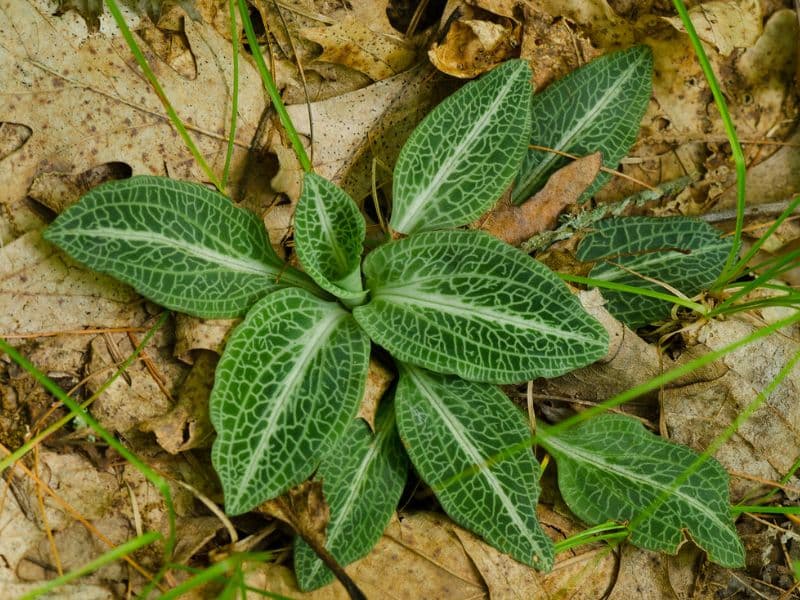
Goodyera pubescens is a plant in the Orchidaceae (orchid) family that is commonly found in North America. The genus Goodyera are terrestrial plants with a fleshy rhizome with basal evergreen leaves in a rosette pattern – frequently having white or pale green markings. Inflorescences are in the form of a spike of small flowers, usually white with green or brown markings and have fragrant odor. Most of the plants, excluding and petals, are covered in small hairs. The primary difference between Goodyera and Spiranthes (A similar genus in the family Orchidaceae) is that Goodyera have elliptic leaves with white or pale green markings.
Goodyera pubescens flowers in mid July-early September with a small spike inflorescence of between 10 and 57 cylindric flowers. The leaves have the white-green marbling in the form of veins throughout, broadly elliptic to broadly ovate (2.1-6.2 x 1.3–3 cm), with either an acute or obtuse apex. The peduncle (stem that connects the stalk to a floret) is 11–35 cm long. Flowers: Lateral sepals 3.1 – 5.3 mm long with distinct petals of 3.6 – 5.7mm.
The petals lip is scrotiform (pouch shaped) 2.5 – 4.2 x 2.2 – 3.5mm in size with the apex reflexed (bent outwards) with a slightly tuberculate (bumpy/rough) outer surface. The inner surface is smoother but has thicker veins throughout. The anthers are inflexed (bent inwards) within a cup-shaped clinandrium (an orchid structure beneath the anther). The white flowers are usually atop a leafless stalk.
There are similar species within the genus Goodyera that G. pubescens can be confused with. The Dwarf Rattlesnake plantain G. repens has smaller flowers that only have inflorescence on one side of the stalk. Both G. tesselata and G. oblongifolia are only found in Canada. Goodyera tesselata can be differentiated by its dull green leaves with much paler veins, G. oblongifolia leaves only have one primary vein compared to the more dense network of veins of G. pubescens. All of the rattlesnake plantains (Goodyera) are described as such because their venation resembles snakeskin.
Compared to other orchid genera, Goodyera is fairly hardy, surviving more readily in colder conditions, being able to utilize a wider variety of nutrients, and thriving in more types of soil under more broad lighting conditions. Goodyera pubescens has a germination rate of over 90% even in very cold climates, which is why it is found in very cold climates such as the northern US and Canada.
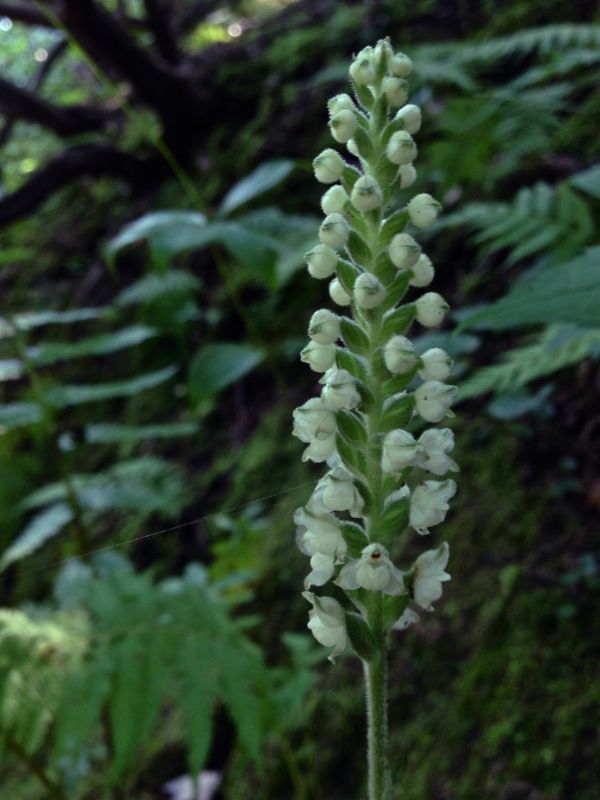
This species prefers loamy soils or humus, but it will also grow into decaying wood of Liriodendron tulipifera or Quercus alba with a preference towards woody substrates with a high amount of fungal activity. However, the rhizomes of G. pubescens cannot survive particularly harsh winters in the northern edge of its distribution.
II. How to Grow and Care
Sunlight
Rattlesnake plantain thrives in partial sunlight, where the light is dappled and indirect, which simulates its natural understory habitat. Due to its tolerance for lower light levels, rattlesnake plantain can also prosper in full-shade environments, although growth may be less vigorous. Adaptations such as the plant’s distinctive leaf patterns enhance photosynthesis efficiency in suboptimal light. Ideally suited to outdoor gardens, rattlesnake plantain flourishes under the canopy of larger plants or in the shadows of buildings. Deviations from these conditions can lead to reduced foliage density and overall vitality.
Temperature
Orchid plants are native to tropical and subtropical regions, preferring warm, moist conditions. Optimum growth temperatures are between 18 to 28 ℃, and it’s best if there is a certain difference in temperature between day and night: for example, 20 to 25 ℃ during the day and 15 to 18 ℃ at night. Rattlesnake plantain is a drought-tolerant plant, but cannot tolerate waterlogging, and grows well at 50-70% humidity. If the leaf tips are withered, it means the environment is too dry. Use a humidifier or spray bottle to increase the air humidity.
Watering
Thriving in its native understory of temperate forests, rattlesnake plantain is accustomed to the moist but well-drained soil conditions found there. This species exhibits a preference for consistent moisture without being waterlogged, indicating a moderate drought tolerance. Care should involve watering every week to maintain its preferred habitat’s balance.
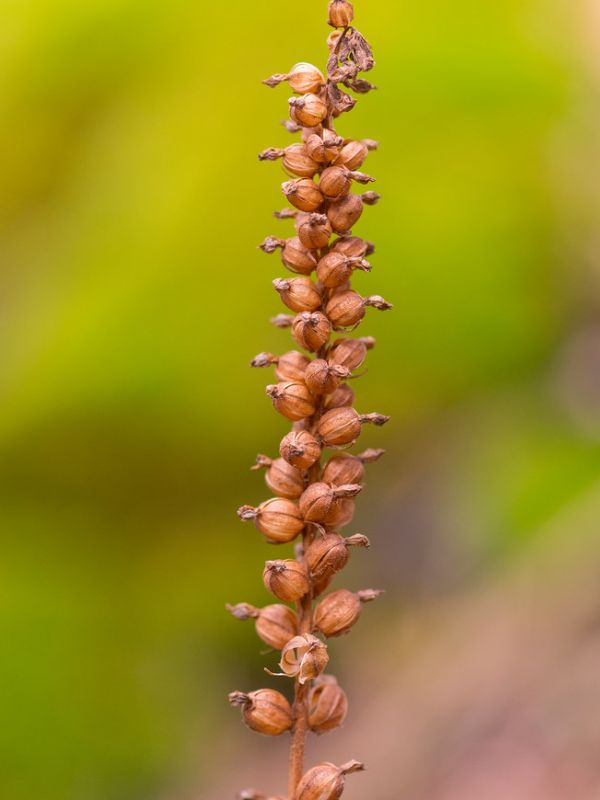
Rattlesnake plantain fares better indoors where stable humidity levels can mimic its natural environment, making it an ideal houseplant. Its evergreen nature means that even outside of the growing season, rattlesnake plantain requires attention to its water needs to sustain those lush leaves.
Soil
The “soil” required for rattlesnake plantain is special because, as an epiphyte, it originally grew on big trees in tropical forests. You need to mimic this growing environment with, for example, water moss, wood chips, coconut shells, volcanic stones, or perlite as soil substrate. You can also buy orchid-specific soil directly from gardening stores.
Fertilizing
For optimal growth, rattlesnake plantain thrives with balanced nutrition fertilizers, such as those with equal NPK ratios. Fertilization should occur monthly during active growing seasons—spring to summer. Use diluted solutions to prevent root burn, applying a quarter-strength mix.
This regimen supports rattlesnake plantain’s health, encourages lush foliage, and bolsters resilience. In dormant periods, like winter, reduce feeding to prevent nutrient overload. When applying, avoid direct contact with leaves to prevent damage. Success with rattlesnake plantain involves understanding its feeding cycles aligned with growth phases, ensuring a vibrant display.
Pruning
It is best to prune wilted rattlesnake plantain flowers promptly after blooming to reduce unnecessary nutrient consumption and promote more blooms. Trim withered and diseased leaves promptly to increase air circulation, thus reducing pests and diseases.
Propagation
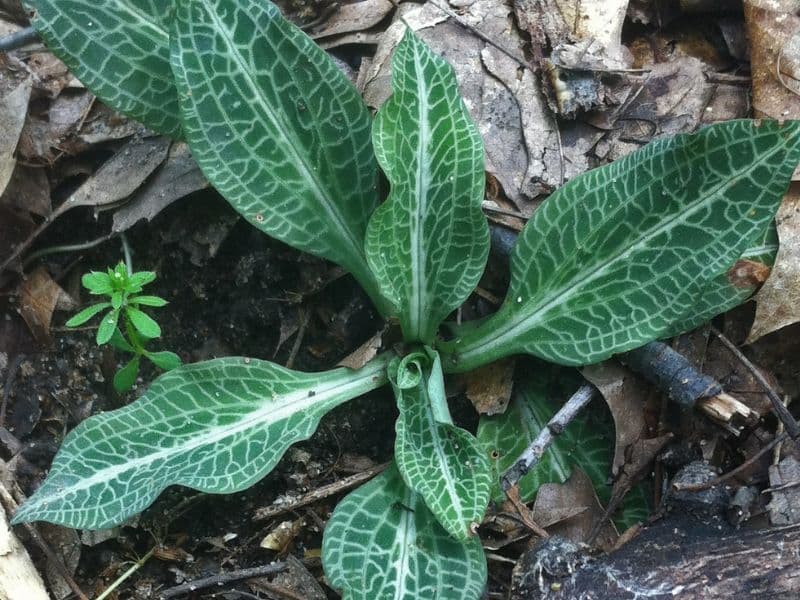
You can propagate rattlesnake plantain by division or by cuttings.
- Propagation by division
Using a rattlesnake plantain with more stems is a better option for the division. You should do this after blooming. When dividing the plant, dig it up carefully with its roots intact, and cut the roots into several clusters from the base. Remember to use clean tools and disinfect the wounds with a fungicide. Then plant your divided clusters in containers and keep them in a cool place. While the new roots are growing, spray them with plenty of water to prevent them from drying out.
- Propagate by cuttings before flowering
Choose a healthy, thick stem, remove the leaves, and cut it into small 2-node pieces. Insert the bottom directly into the substrate. Keep the substrate moist, and they will root and sprout in about 2-3 months. You can also propagate by cuttings by laying the entire stem on top of moist substrate, and cutting it into pieces after it roots and sprouts. Transplant those rooted cuttings into pots for further growth. A third way to propagate by cutting is possible during weather with high temperatures, when the stems develop roots, and you can cut them off and plant them.
III. Uses and Benefits
- Ornamental uses
Goodyera pubescens is largely just seen as a plant kept for visual aesthetic reasons in wildflower plantings due to its interesting leaf structure and resilience.
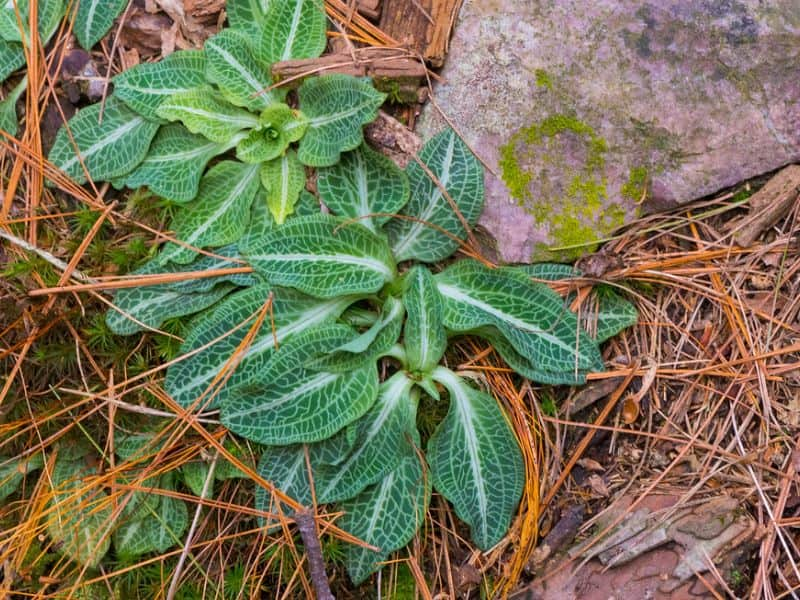
- Medicinal uses
It was once used historically as a medicinal plant by Native Americans for curing numerous ailments. The roots were made into a tea for treating lung inflammation/breathing pain and for snakebites. The leaves were used to improve appetite, cold treatment, kidney problems, joint pain reducer, or even for toothaches. The wilted leaves were used to cool burns, to deal with skin ulcers, or as a pain reliever. These are historical or cultural uses and are no longer currently recommended.
IV. Harvesting and Storage
If you want to display rattlesnake plantain flowers in vases, harvest there are only 2-3 flowers blooming on the stem. Cut diagonally at the bottom of the flower stem, and place it in a vase immediately. You can enjoy the cut flower in clean water for about 14 days, or for a longer time with preservatives.
Find Where to Buy the Best Downy Rattlesnake Plantain (Goodyera pubescens)
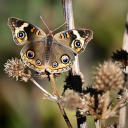






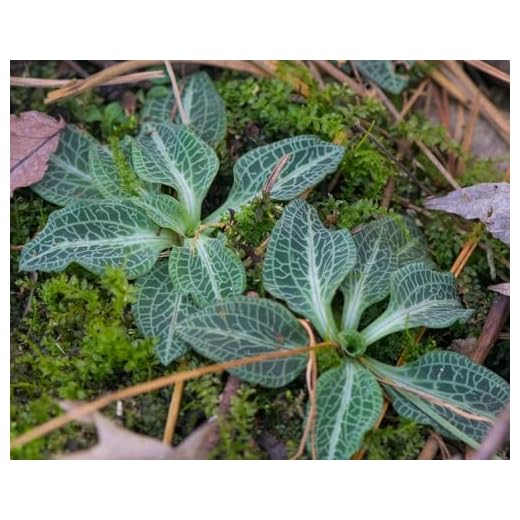










Leave a Reply